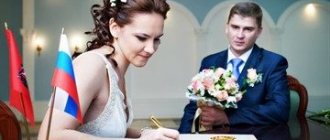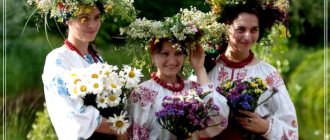In ancient times, agriculture was considered almost the only way to ensure the well-being of a family. For most of the year, the population of Rus' was busy raising crops and then harvesting them. In the fall there came a period when there was significantly less work. For this reason, this time of year has become particularly popular for matchmaking and wedding celebrations. Thanks to this factor, autumn received a special characteristic, and it began to be called “wedding time.”
Autumn is the time for weddings
In Rus', weddings were held not only in the fall, but the reasons for the popularity of this time of year as a time of celebration are due to the ordinary everyday features of the life of the Russian people. The life of people of that time was closely connected with church traditions, which everyone had to accept, as well as some everyday nuances. The ability to organize festivities in the spring, for example, was an impossible task for ordinary villagers. All material resources and own forces were directed towards preparing for the main task - the start of agricultural work.
Prosperous and wealthy representatives of the Russian people held weddings at any time of the year, but autumn always remained a priority. Traditionally, the wedding season opened simultaneously with the celebration of Krasnaya Gorka on the first Sunday after Easter and ended in the last days of November. Modern newlyweds want to celebrate their wedding in the fall for other reasons that are not related to seasonal work or other factors that played a major role in the old days.
Modern advantages of autumn as a wedding season:
- It is difficult to gather guests in the summer due to the holiday period;
- nature in autumn is particularly beautiful and rich in colors;
- Most vegetables and fruits ripen in autumn.
Wedding day.
The main manager at the wedding was the best man. As a rule, he was the elder brother or close friend of the groom. The friend monitored the correct performance of all wedding rituals accepted in this community. The groom, his groomsmen and relatives went to the bride's house. This procession was called the wedding train. The road in front of the wedding train was ritually swept, otherwise an object that had been damaged could be thrown on it. The bride ransom was carried out in front of the house. Sometimes an old woman was given to the groom instead of the bride, and another woman was brought out covered with a scarf. Then the groom had to ransom the bride again. Next, the bride and groom went to the church to get married, and then to the groom’s house for the wedding feast. The wedding feast could last 2 or 3 days.
Wedding feast.It's time for weddings in Rus' according to the church calendar
Traditionally, the time for weddings in Rus' began with the day of Simeon the Stylite, which was celebrated on September 14, and ended at the end of November, simultaneously with the beginning of Lent. Among the existing temple holidays, there were special days when getting married was not only recommended, but was even considered a good omen. The most favorable periods for marriage, as well as weddings, are the Autumn Meat-Eater, the Winter Meat-Eater and the beginning of summer.
Autumn meat eater
The favorable period for weddings, which begins on August 28 and ends on November 28, is called “Autumn Meat Eater.” Its starting point is the Dormition, and its ending is the Nativity Fast. The most important holiday for girls during the Autumn meat-eating period is Intercession (October 14). According to custom, on the eve of this day one had to ask the Most Holy Theotokos to meet with one’s betrothed. Weddings played on this day are the happiest.
“Second Autumns” is a holiday that was traditionally celebrated on September 21. On the one hand, this long-awaited day marks the completion of work and harvest, on the other hand, it is the best time to celebrate weddings. The more common name for this holiday is the Nativity of the Virgin Mary. She is the main helper of women and mothers, so marriages concluded on this day are the strongest.
Winter meat eater
Winter meat-eater is the time of weddings, which begins a few days after Christmas and ends with Maslenitsa. In Rus', these few weeks were called “wedding”. There are no church holidays at this time, so parents of unmarried and unmarried children actively matched their children, and also held noisy weddings. The time for celebrations began immediately after the end of Christmastide. Until January 19, the Church does not hold wedding ceremonies.
In February, you should be careful when choosing a wedding date. Maslenitsa week begins on the 16th, and Lent begins on February 23. It is better to get married before this period. Valentine's Day (February 14) is a particularly popular holiday. On this day, millions of couples tie the knot. According to church traditions, it is recommended to get married before February 16th. Marriages concluded during this period are happy and promise the newlyweds a quiet life in peace and mutual understanding.
It is not recommended to celebrate weddings in December. This is due to the Nativity Fast. According to legend, families created during this period are doomed to failure. In the old days, the wedding ceremony was a mandatory tradition. Fasting prohibits wedding festivities, weddings, and also imposes significant restrictions on the festive table. December is the busiest month in terms of church prohibitions.
Spring-summer time
The next wedding season opens on the first Sunday after Easter. Traditionally, this period is called the spring-summer time of weddings and celebrations. Weddings continued to take place until Trinity Sunday. This tradition is also popular among modern newlyweds. According to statistics, the holiday has been characterized as a wedding boom for many years.
In the old days, it was believed that marriages concluded on Krasnaya Gorka received support from above. According to legends, young families created on this day will definitely be happy and strong. Krasnaya Gorka lasts one week. The period got its name from the tradition of celebrating spring with mass events that unite all residents of the village. For celebrations in Rus', the highest points of villages and hamlets were chosen. The main attention during the festivities was paid to unmarried girls and boys. During the celebrations, potential grooms proposed to their brides.
The girls wore their most beautiful dresses and jewelry, trying in every way to attract the attention of their chosen ones. It was believed that a young man who douses a girl with water during the celebration of Krasnaya Gorka must definitely come to her in the near future to woo her. All unmarried beauties expected such an act from their gentlemen.
Summer is a difficult time for newlyweds. At this time, it is difficult to choose a suitable wedding date. May is the main unfavorable month for weddings. In June and July, Trinity Week, Petrov and Apostolic Lent practically replace each other. If you manage to choose a wedding date outside of church holidays and falling on the desired day of the week, then special attention should be paid to ancient signs. According to legend, June promises a sweet life, and July is compared to a sweet and sour berry.
On what days do weddings not take place?
According to the church calendar, some dates are undesirable for weddings. Previously, it was forbidden to carry out weddings on important church holidays, periods of fasting, as well as some specific days of the week. The first two nuances have survived to this day, and significant changes have occurred with the days of the week suitable for marriage. In Rus', for example, it was forbidden to have weddings on Wednesdays or Fridays. The modern traditional days for painting are Friday and Saturday.
Periods when you cannot have weddings or get married:
- Maslenitsa week (“to marry on Maslenitsa means to become intermarried with misfortune”);
- the month of May (“getting married in May means toiling all your life, not seeing happiness”);
- period of fasts (Uspensky, Great, Rozhdestvensky, Petrov);
- Christmastide period;
- Tuesday, Thursday any time of the year;
- September 11 and 27 (days of the beheading of John the Baptist and the Exaltation of the Holy Cross).
Complete data on unfavorable days for marriage are contained in special church calendars. If the date is designated as a church holiday, then getting married or having a wedding is not recommended. Such calendars are sold at newsstands or church shops. If you follow traditions and believe in omens, then you should definitely have such a cheat sheet with you.
Early marriages
When to start a family is a difficult question for both men and women. However, in the Middle Ages in Europe, the question of “when” was not particularly discussed. Arranged marriages were not uncommon, with parents making arrangements for their children, sometimes before they were born.
The main purpose of such agreements was the political and/or economic benefit of both families. Of course, no one cared about the consent of the children. And the attitude towards the institution of marriage was quite peculiar: the wife was considered, sadly enough, the property of her husband, with all the ensuing consequences.
According to available historical documents, the age for marriage was 14 for boys and 12 for girls. Obviously, at this age there is no talk of any voluntary desire to start a family.
One of the reasons for such early marriages was the short life expectancy. As you know, in the Middle Ages a forty-year-old man was considered almost an old man. The average life expectancy a couple of centuries ago was no more than thirty years, and therefore, by postponing the wedding to a later date, it was possible not to get married.
Wreaths and ribbons
For example, the bride's headdress apparently originated from a simple wreath of flowers that was used to decorate the newlywed's head in ancient times. A peculiar interpretation was wide ribbons that were tied on the head or hoops decorated with flowers.
Kokoshnik, late 18th century. (Wikimedia Commons)
A little later, kokoshniks began to appear, embroidered with beads and ribbons, and this headdress was intended exclusively for a married woman. The bride could let her hair down, and after marriage she would braid it in two braids. Special decorations in the form of ribbons with beads and fringed braids were called “kosniks”. Sometimes the bride wore an embroidered veil under her headdress, which later turned into the familiar veil. Often long colored ribbons were attached to the back of the hoop or headband and fluttered in the wind. This headband was called a “volushka”, and after the wedding the bride gave it to her younger sisters or bridesmaids as a symbol of girlhood.
The wedding night.
The wedding night.
The first wedding night in Rus' was treated extremely responsibly. It was considered a ritual transition to the New Life and was accompanied by numerous instructions and amulets. The young were sent to sleep in an unheated, cold room, in a cage, in a cold room, or even in a barn. And this despite the fact that weddings were most often celebrated in winter. The bed was made in a special way and various amulets, sticks, money, eggs, various herbs and sweets were placed in it. They also carefully checked whether anyone had put mixed dog and cat hair in the bed. In this case, discord occurs in the family. In the Russian north, the ritual of removing the groom's shoes was popular. It symbolized the wife's submission to her husband. The young woman took off her husband’s right boot, and he hit her with a whip, which he took out of his left boot. The awakening of the young was also considered a special ritual. The next morning, guests who had been partying at the wedding came to the door. They shouted, sang songs, played the balalaika and accordion, and broke dishes in order to wake up the newlyweds as loudly as possible. After waking up the newlyweds, the bride's virginity was checked. This was not accepted in the Russian north. But in the southern regions of Russia, as well as in Belarus and Ukraine, the purity of the bride was a public matter. And if the bride turned out to be dishonest, her parents and the matchmaker could be ridiculed, hung a collar around her neck, and served beer to her father in a leaky glass.
Summer meat eater
Weddings were also held during the summer meat-eating period - the period between fasts when it is allowed to eat meat. The summer meat-eating period began after Peter's Lent on Peter's Day (June 29) and lasted until the Assumption Lent (August 1).
It is interesting that, together with Ivan Kupala and Agrafena Bathing, Petrov's Day forms a protracted holiday cycle dedicated to the dawn of nature. And it was on Peter’s Day that girls had many chances to get married, because during festivities, games, and rituals it is easier for a guy to like him.
The end of the wedding.
Wedding.
The wedding continued on the second and third days. The second day of the wedding was considered a test for the young wife. She bowed, brought a glass and a gift to each relative according to seniority, and answered questions. Then the young woman prepared food, showed her dowry, and demonstrated her household skills. The third and last day of the wedding was called “honor, guest, leave, walk, bread (emphasis on i). it meant mutual visits of the young relatives to get to know them more closely. In contrast to the sad tone of the wedding eve, the end of the wedding is marked by fun games and jokes of the mummers, many of which are similar to Maslenitsa and New Year's festivities. The mummers stage buffoonery and outrages, steal chickens, beg for food, things, money and organize a joint feast.
Mummers at a wedding.











